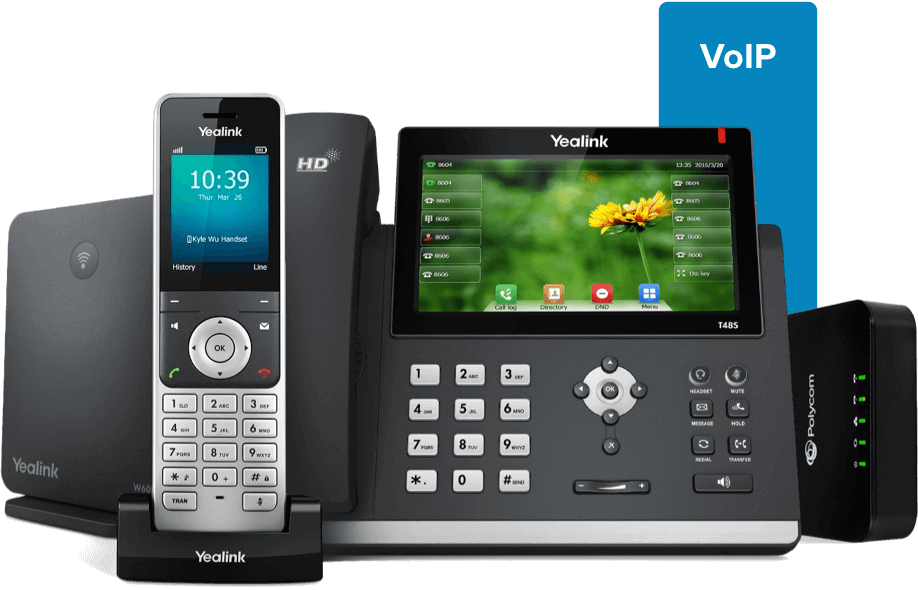Voice over IP: What it is and why businesses use it
Voice communications through the internet—formerly known as IP telephony


First, what exactly is Voice over IP?
Voice over IP (internet protocol), aka VoIP, is the technology that lets you make voice calls using broadband connections. This means that unlike with phone calls, you don’t need a public-switched telephone network (PSTN) to make a call. To make and receive calls over the internet, you can use any VoIP-enabled device, a computer with VoIP software, or even a landline phone connected to an analog telephone adapter (ATA).
As the name suggests, it is designed to transmit voice communications (in other words, phone calls) over the internet.
Why is voice over IP so important?
To say that VoIP technology has changed the way that people and businesses communicate would definitely not be an understatement.
For one, calls aren’t restricted to a single device anymore as people can now choose to use IP phones, computers, or mobile devices. That’s because VoIP allows different forms of communication—voice calls, SMS, video calls, conference calls, etc.—to take place on a single IP network. Not only that, businesses can also get rid of their clunky, on-premises PBXs (think of those old desk phones that every office used to have) too.
So ultimately, what do these things mean for businesses?

The advantages of VoIP
Cost Savings
You don’t need to pay all the costs that come with traditional phone companies. Basically, it saves you money. Potentially, lots of it.
Direct cost savings can come from:
- Lower hardware expenses: Every company knows how expensive it is to set up a traditional phone system. You’ll need to pay for, among other things, the dedicated copper wiring (which carries the voice communications) and the on-premises PBX system (which connects the landline phones in your office to one another). With VoIP, you could do away with all that hardware.
- Lower operational expenses: When a call is routed through a public-switched telephone network (aka. A traditional phone network that uses copper wires), a dedicated circuit is opened between the caller and the recipient, and it should remain open until the call ends. Otherwise, you'll hear delays on the call—this is probably something you’ve experienced on long-distance and international calls, because it’s harder to keep the circuits open when voice signals take longer to reach their recipient. (This is also why phone companies charge for calls like this on a per-minute basis.) Because VoIP relies on the internet, you won’t get this issue. You aren’t charged by the minute either, which saves you even more money, especially if you make lots of long-distance and international calls. (VoIP providers charge on a subscription basis, with plans that cater to specific needs.)
- Lower recurring expenses: Ongoing expenses like repair and maintenance fees can easily overwhelm your budget. But not if you get a hosted VoIP service, which typically rolls these costs into reasonably priced monthly subscription plans that fit your needs. You can sometimes even get additional features like call waiting and an auto attendant at no extra cost.
Now, let’s look at indirect cost savings:
- A remote work setup: With advanced functionality like conference calling and video conferencing, voice over IP makes it easier and more efficient to work remotely, which cuts down the costs of your office and utility bills.
- Repurposed human resources: Some advanced VoIP features can even cover repetitive tasks for you so that you can focus on actually valuable work. For instance, you might be thinking of hiring someone to handle phone calls (which translates to money spent on additional salary and benefits) or maybe giving the work to an existing employee, (which would probably require you to give them a raise). With the auto attendant feature, you won’t need a receptionist at all. That’s a load of savings every month.
Scalability
Your VoIP system grows with you, letting you easily add and delete phone lines or extensions any time. Again, you don’t have to pay anything extra to do this. Bonus!
Super-portability
VoIP allows you to make and receive calls from anywhere using any device (and using the same number) as long as there is an internet connection. It follows you wherever you go, and you’ll still be able to use its features without a hitch. Having remote teams or letting people work from home is pretty much impossible with traditional telephone systems, in which your number is assigned to a specific line.

The Disadvantages of VoIP
Call quality
As long as you have an adequate internet connection, routers and cables, you can easily avoid issues like lost audio and latency (delays).
Emergency Support
Because VoIP calling happens over the internet, it’s almost impossible to trace the locations of callers.
- Fixed - the service is associated with the account user's address and can’t be obtained by anyone outside of the country. RingCentral is a good example of a fixed VoIP provider.
- Non-fixed - doesn't need to be associated with a physical location and is therefore easily obtainable by anyone from outside the country.
Required Internet Connection
VoIP carries voice calls (as well as texts, faxes, video chats, and other types of data) across the internet. This means that for your VoIP phone service to function, you will need a reliable, high-bandwidth Internet connection.
Data Security
You’ve probably seen some news about major corporations’ emails being hacked, so you likely have an idea that data traversing the internet is not necessarily secure.
If you choose the wrong provider, your company’s data will definitely suffer from a lack of security.
How does voice over IP work?
VoIP takes a standard analog phone call—the type most homes and businesses still make today over the Public Switched Telephone Network (PSTN)—and converts that analog call into digital packets. Then, rather than traveling over the standard phone network, those packets are transmitted across the internet to the other parties on the call. Voice packets of a VoIP calls travel over the internet just like any other type of digital data, such as an email message or a file being uploaded to your favorite cloud storage app.
When you speak into the microphone of your device, you generate analog voice signals, which are converted into packets of data (aka “compression”). These VoIP packets are transmitted over the internet and converted back to analog voice signals (or “decompression”) for the person on the other end to understand. The process of compression and decompression is made possible by special algorithms called codecs (COder-DECoder).

VoIP technology is made up of different protocols (think of them as rules built into your software) working together to deliver voice and multimedia communications (like when you’re video-chatting with someone!) over an IP network. These work simultaneously in real-time and do different things, like:
Session initiation protocol (SIP): Real-time convos
Session initiation protocol is responsible for starting, establishing, and ending real-time conversations between two or more people, whether on a two-way or multi-party call. This is possible through “SIP trunking,” which is a service that’s usually offered by an internet telephony service provider (ITSP).
The ITSP uses a SIP trunk to connect one or multiple channels to your private branch exchange phone system (or PBX), so you don’t need a physical connection to a telephone company—and you can make calls over the internet. Think of a SIP trunk as the virtual version of a traditional phone line (it's installed over your internet connection rather than through wires).
Real-time transport protocol (RTP)
Real-time transport protocol is responsible for carrying every media stream—which, again, in the VoIP world exists as a “digital voice data packet”—back and forth during a call. This is also what makes it possible for you to watch your favorite Netflix and YouTube shows.
Other VoIP Protocols: Transmission Control Protocol (TCP) & User Datagram Protocol (UDP)
It relies on other VoIP protocols too, like transmission control protocol (TCP) for accuracy and user datagram protocol (UDP) for speed. Oh, and RTP has a secure version too: secure real-time transport protocol (SRTP).
How do you make a VoIP phone call?
VoIP-to-VoIP calls
When you make a call, the audio data is encapsulated or compressed into small data packets. These packets travel through different networks until they reach their destination (the IP phone or computer of the person being called), where the packets are “unpacked” back into audio form. This goes back and forth in real time.
One great thing about VoIP is that there’s no one way to make a call. Legacy phone systems only let you communicate from phone to phone. On the other hand, VoIP lets you call from:
Computer to computer
The process is pretty simple:
- Download a VoIP-enabled program and install it on your computer.
- Create an account.
That’s all you need to make a computer-to-computer call, which is free (as long as the person you’re calling is also using the same application). This setup is great for personal use but could be a problem for businesses as it typically lacks security protocols and falls short when it comes to sound quality and integrating with other tools.
Computer to phone
Here’s how you do it:
- Have your VoIP provider enable out-of-network calls (not free, but still cheaper than services from traditional phone companies).
- Connect to a landline phone using a computer running a VoIP-enabled program.
And that’s it! Businesses that regularly make calls to areas without a strong internet connection would benefit most from a computer-to-phone option.
Mobile apps
This option is great for remote workers:
- Download a mobile version of a VoIP-enabled program and install it on your device. Create an account.
If you have field or remote workers, it’s probably more convenient (and will make things run more smoothly) if you have mobile apps.
Landline phones connected to an ATA
How to do it:
- Plug your phone cable into the ATA.
- Start making VoIP calls by picking up the handset and dialing.
Some companies use an ATA to get a feel for VoIP first before going all in.
VoIP to PSTN (and vice-versa)
When you make a call through IP to a landline, the digital audio goes through the same process as a VoIP-to-VoIP call. The difference is that the unencapsulated audio data passes through what’s called a VoIP gateway, which in turn converts digital audio to analog.
VoIP phone system: Application of VoIP to Business
What is a VoIP phone system?
While VoIP is responsible for basic phone functions, most VoIP providers add PBX capabilities to the equation in order to provide businesses with a system that can manage all their incoming calls. This solution is commonly referred to as VoIP phone systems.
A VoIP phone system allows you to integrate more of your company’s business communications into a single solution, rather than leaving you to manage many different communication tools and vendors—which don’t always work well together.
Features of a VoIP phone system
Most small- and medium-sized businesses believe that they do not need a professional business phone system. More often than not, they think their operations are too small for such an investment.
However, a professional VoIP phone system might just be what they need to take their business to the next level. By getting a VoIP phone system, your business gets the following:
- A virtual telephone number that users can access even outside the office
- An auto attendant that promptly answers all phone calls and routes them to the right person or department (no more missed calls!)
- A system that reduces the need to pay for expensive mobile phone plans because workers can use VoIP to make calls instead
- Advanced communications features that can increase efficiency and productivity
- Advanced team collaboration tools like online meetings, team messaging
RingCentral: The Best VoIP Provider

VoIP systems let you free your staff from being tied to their desks because their office phone numbers will no longer be limited to any particular phone. For example, with the RingCentral desktop app, you can give your team the ability to make business calls on their desktop or laptop using nothing but an internet connection, a microphone and speaker setup or headset, and the RingCentral app itself.
In addition to full softphone capability, the RingCentral desktop app gives your staff a single interface for other communication services they likely use every day—such as team messaging and collaboration, file sharing, task management, and online meetings.
With the RingCentral mobile app, your team can also enjoy all of this unified communications functionality—VoIP phone calls, texting, conferencing, online meetings, even team messaging and collaboration—from a single app on their smartphones.
In other words, a VoIP system acts as a full-scale cloud PBX (or even more than that in the case of RingCentral), allowing your team to easily manage calls and other communications features, including auto attendants with recorded greetings, advanced call routing and forwarding services, virtual voicemail, and even online faxing.
RingCentral Business Communications plans for your small business
VoIP FAQs
- Desk IP phones: Connected directly to your router, these standard business VoIP phones look like regular landline telephones. The difference is that they typically have an LCD screen that displays programmable buttons, caller ID, and more. Some desk IP phones even give you the option to customize the background image!
- Wireless phones: These are just mobile handsets with the functionality of a desk IP phone. Wireless phones have built-in Wi-Fi so you can make calls wherever there’s a wireless broadband connection.
- Conference phones: You’ve seen these in big conference rooms. Conference phones let you call multiple people at once and have a big meeting even when the callers are scattered around the world.
- USB phones: A USB phone connects to the USB port on your computer, so you can make VoIP calls (as long as you have VoIP software installed).
- PSTN (circuit switching) - When person A calls person B, the network tries to find a connection from different circuits (sort of like paths or trails with gates). Once a connection is established, the conversation takes place and the circuit stays open until the call is finished.
- VoIP (packet switching) - When person A calls person B, person A’s voice signals are broken down into data packets (as explained above). Each packet contains the source and destination addresses (where the message comes from and where it’s going). This is important, since the packets may take different routes. When they arrive, the destination device (phone or computer) reassembles them into person A’s original voice signals. The same thing happens to person B’s voice signals as the conversation goes on.



